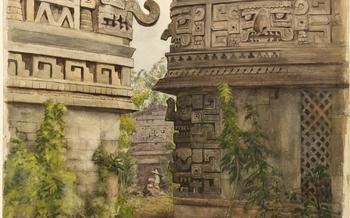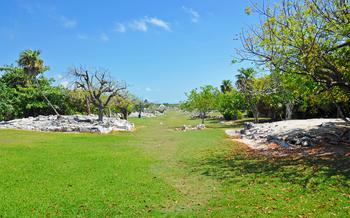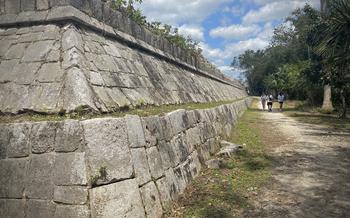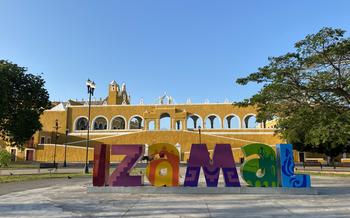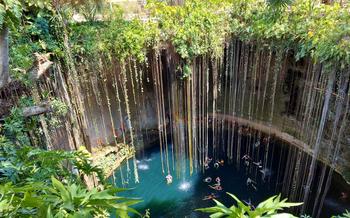
Cenote Dzitnup
- Cenote Dzitnup: A Hidden Gem in the Yucatan Peninsula
- Unveiling the Enchanting Beauty of Cenote Dzitnup
- Exploring the Cenote's Underwater Caves
- Discovering the Legends and Myths of Cenote Dzitnup
- Tips for Planning Your Visit
- Conservation and Sustainability at Cenote Dzitnup
- Unforgettable Experiences at Cenote Dzitnup
- Cultural and Historical Significance of Cenotes
- Cenote Dzitnup: A Place of Tranquility and Adventure
- Local Cuisine and Cultural Immersions
- Safety Precautions for a Safe and Enjoyable Experience
- Alternative Cenotes in the Yucatan Peninsula
- The Ancient Maya and Water
- Insider Tip: Hidden Pathways and Secret Spots
Cenote Dzitnup: A Hidden Gem in the Yucatan Peninsula
Cenote Dzitnup, nestled in the heart of the Yucatan Peninsula, is a natural marvel that beckons adventurers and nature enthusiasts alike. This subterranean wonder, formed by the collapse of a limestone bedrock, reveals a breathtaking world of crystal-clear waters, unique rock formations, and abundant wildlife.
Once a sacred site for the ancient Maya, cenotes held profound cultural significance. They served as a vital source of fresh water, a place for religious ceremonies, and a connection to the underworld. Today, Cenote Dzitnup continues to captivate visitors with its stunning beauty and rich history, offering a glimpse into the harmonious coexistence of nature and culture.
To reach this hidden gem, one can embark on a scenic drive from popular tourist destinations such as Cancun or Playa del Carmen. The journey leads through lush Mayan jungle, dotted with ancient ruins and vibrant local communities. The anticipation builds as the road winds its way towards the cenote, promising an encounter with a natural wonder that has remained largely untouched by time.
Unveiling the Enchanting Beauty of Cenote Dzitnup
The moment you set your eyes on Cenote Dzitnup, you are transported to a realm of unparalleled beauty. Its crystal-clear waters shimmer in mesmerizing shades of blue, inviting you to dive in and explore its depths. The cenote's unique rock formations create an otherworldly atmosphere, with stalactites and stalagmites hanging from the ceiling and rising from the depths like ancient sentinels. The abundant aquatic life adds to the magical ambiance, with colorful fish darting in and out of the rocks and turtles gliding gracefully through the water. The lush vegetation surrounding the cenote provides a verdant backdrop, completing the picture of paradise.
Exploring the Cenote's Underwater Caves
Cenote Dzitnup boasts a series of interconnected underwater caves, accessible to adventurous snorkelers and divers. These caves offer a glimpse into the subterranean world, revealing a hidden realm of stalactites, stalagmites, and shimmering rock formations. The crystal-clear waters provide excellent visibility, allowing visitors to observe the diverse marine life that thrives within these caves. Schools of colorful fish dart through the water, while turtles glide gracefully past, creating a mesmerizing underwater ballet.
Exploring the caves requires a sense of adventure and respect for the fragile ecosystem. Snorkelers and divers should be mindful of their movements, avoiding contact with the delicate rock formations and marine life. The caves offer a unique opportunity to witness the intricate beauty of the underwater world, while also gaining an appreciation for the importance of preserving this natural wonder.
Discovering the Legends and Myths of Cenote Dzitnup
Cenotes hold a significant place in Mayan mythology and culture, serving as sacred portals to the underworld. Cenote Dzitnup is no exception, steeped in legends and myths that have been passed down through generations. According to one tale, the cenote was once a secret meeting place for Mayan deities, who would gather in its depths to discuss the fate of the world. Another legend speaks of a hidden treasure hidden within the cenote, guarded by a powerful water spirit. These stories add an enchanting layer to the allure of Cenote Dzitnup, making it a place of not only natural beauty but also cultural and spiritual significance.
In ancient times, cenotes were considered sacred places, and many ceremonies and rituals took place around them. The Maya believed that cenotes were connected to the underworld, and they used them as a means to communicate with their ancestors and deities. Offerings were made to the water spirits, and people would often bathe in the cenotes to purify themselves before religious ceremonies.
The spiritual connection between cenotes and the Maya is still strong today. Many Maya people still believe that cenotes are sacred places, and they often visit them to pray and make offerings. Cenotes are also seen as a source of healing and renewal, and people often come to them to bathe and meditate.
Tips for Planning Your Visit
To plan a fulfilling visit to Cenote Dzitnup, consider the following tips and recommendations:
-
Timing Your Visit: Aim for an early morning or late afternoon visit to avoid crowds and bask in the enchanting ambiance. The sun's golden rays create a magical play of light and shadow within the cenote, enhancing its beauty.
-
Duration of Stay: Dedicate at least two to three hours to fully immerse yourself in the cenote's wonders. This allows ample time for swimming, exploring the caves, and simply relaxing in this tranquil paradise.
-
Essential Items: Pack a swimsuit, towel, comfortable clothing for the journey, and sturdy water shoes for navigating the cenote's rocky terrain. Consider bringing a waterproof camera or GoPro to capture your underwater adventures.
-
Facilities Available: Basic facilities are available on-site, including restrooms, showers, and changing rooms. Keep in mind that these facilities may be limited, so plan accordingly.
Conservation and Sustainability at Cenote Dzitnup
Preserving the natural beauty and ecological integrity of Cenote Dzitnup is of utmost importance. Responsible tourism practices and sustainable initiatives are essential to ensure the long-term health of this natural wonder. Visitors are encouraged to minimize their environmental impact by adhering to designated trails, avoiding the use of harsh chemicals, and properly disposing of waste. Local communities play a crucial role in protecting the cenote, working in collaboration with environmental organizations to implement conservation measures. By supporting local efforts, visitors can contribute to the preservation of this unique ecosystem for future generations to enjoy.
Unforgettable Experiences at Cenote Dzitnup
The tranquility of the cenote is an allure that extends beyond its crystal-clear waters. The serene atmosphere of the cenote is perfect for relaxation and contemplation. The gradual transition of colors as the sun dips below the horizon, painting the sky in hues of orange, pink, and purple, is a spectacle not to be missed. Relax by the cenote's edge and let the beauty of the sunset soothe your mind and soul.
Night swimming at Cenote Dzitnup offers a different kind of magic. Immerse yourself in the cenote's tranquil waters under the starry canopy of the night sky. The reflection of the stars in the water creates a mesmerizing effect, making it an unforgettable experience.
For those with a passion for photography, the cenote presents an ideal opportunity to capture stunning images. The interplay of light and water, the vibrant colors of the aquatic life, and the unique rock formations create a photographer's paradise. Capture the beauty of the cenote above and below the water's surface, creating memories that will last a lifetime.
Every moment spent at Cenote Dzitnup is a chance to create unforgettable memories. Whether it's swimming, snorkeling, diving, or simply relaxing amidst the tranquil surroundings, the cenote offers a unique and magical experience.
Cultural and Historical Significance of Cenotes
The Maya, who were the ancient inhabitants of the Yucatan Peninsula, held cenotes in high esteem for their vital role in providing water for their communities. These natural wells were the primary source of fresh water for the Maya, sustaining their agricultural practices and ensuring their survival in the region's often-arid climate. Cenotes played a crucial role in the development of Mayan civilization, allowing them to establish settlements and thrive in the midst of the peninsula's dense jungle.
Beyond their practical importance, cenotes held deep spiritual and religious significance for the Maya. They were considered sacred places, gateways to the underworld, and portals to communicate with the gods. Cenotes were often used for ceremonial purposes, including offerings, rituals, and pilgrimages. The Maya believed that cenotes were inhabited by water spirits and deities, and they revered these natural wonders as places of immense spiritual power. The cultural and historical significance of cenotes cannot be overstated, as they were integral to the Maya's way of life and their profound connection to the natural world.
Cenote Dzitnup: A Place of Tranquility and Adventure
Cenote Dzitnup offers a captivating blend of tranquility and adventure, catering to diverse preferences. The serene atmosphere invites relaxation and contemplation amidst the pristine natural surroundings. Visitors can immerse themselves in the tranquil waters, surrounded by lush vegetation and the gentle sounds of nature. The cenote provides a sanctuary for those seeking inner peace and a connection with the natural world.
On the other hand, Cenote Dzitnup presents ample opportunities for adventure enthusiasts. Cliff jumping from various heights adds an exhilarating element to the experience, allowing thrill-seekers to push their limits. The cenote's crystal-clear waters offer excellent visibility for snorkeling and diving, revealing a vibrant underwater world teeming with diverse marine life. Adventurous souls can explore the cenote's hidden caves and passageways, discovering the secrets that lie beneath the surface.
Local Cuisine and Cultural Immersions
A visit to Cenote Dzitnup offers an opportunity to immerse yourself in the rich culinary traditions of the Yucatan Peninsula. Numerous local restaurants in the vicinity serve authentic Mayan cuisine, allowing you to savor the flavors and aromas of this vibrant region. Indulge in traditional dishes such as cochinita pibil, a slow-cooked pork dish infused with achiote and wrapped in banana leaves, or panuchos, fried tortillas topped with beans, cochinita pibil, and pickled red onions.
Beyond culinary delights, the area surrounding Cenote Dzitnup is steeped in cultural heritage. Engage with local communities to gain insights into their way of life, traditions, and customs. Visit nearby villages, attend cultural events, or participate in hands-on activities such as cooking classes or traditional dance lessons. Supporting local businesses and the economy is crucial for preserving the cultural fabric of the region, so consider purchasing souvenirs and handicrafts from local artisans.
Safety Precautions for a Safe and Enjoyable Experience
Cenote Dzitnup is generally a safe place to swim, but it's essential to follow safety guidelines and regulations to ensure a safe and enjoyable experience.
-
Always swim within designated areas. There may be restricted areas or areas with strong currents or uneven surfaces, so it's important to stay within the designated swimming zones.
-
Wear appropriate footwear. The cenote's bottom can be slippery, so wearing water shoes or sandals with a good grip is recommended to prevent slipping and injury.
-
Be aware of your surroundings. Pay attention to the depth of the water, the presence of underwater obstacles, and any wildlife that may be present.
-
Don't swim alone. It's always safer to swim with a buddy or group, especially if you're not a strong swimmer or are unfamiliar with the cenote.
-
Lifeguards are typically present, but it's still important to be responsible for your safety and follow the guidelines.
-
In case of an emergency, seek help immediately. Lifeguards are trained to handle emergencies, so if you or someone else needs assistance, don't hesitate to call for help.
Alternative Cenotes in the Yucatan Peninsula
While Cenote Dzitnup offers an enchanting experience, the Yucatan Peninsula is home to a plethora of other cenotes, each with its own allure. For an unforgettable cenote-hopping adventure, consider exploring these alternative gems:
-
Cenote Ik Kil: Located near Chichen Itza, this popular cenote is renowned for its stunning blue waters and impressive stalactites. It's ideal for swimming, diving, and admiring the natural beauty.
-
Gran Cenote: Known for its crystal-clear waters, Gran Cenote is a haven for snorkelers and divers. Its underwater caves and caverns offer a glimpse into the subterranean world, teeming with diverse marine life.
-
Cenote Azul: Immerse yourself in the vibrant blue waters of Cenote Azul, surrounded by lush vegetation and dramatic rock formations. It's perfect for cliff jumping, swimming, and taking Instagram-worthy shots.
-
Cenote Suytun: Experience the magic of Cenote Suytun, a hidden gem tucked away in the jungle. Its secluded location and pristine waters make it a tranquil spot for relaxation and swimming.
-
Cenote X'keken: Discover the charm of Cenote X'keken, with its shallow, crystal-clear waters ideal for families with young children. Its unique rock formations and abundant fish life make it a great place for snorkeling and swimming.
The Ancient Maya and Water
To the ancient Maya, water was a sacred and life-giving force intricately entwined with their culture and civilization. Cenotes, with their crystal-clear waters and mysterious depths, held a profound significance. The Maya believed that cenotes were portals to the underworld, the realm of gods and ancestors. They performed elaborate rituals and ceremonies at cenotes to honor their deities, seek guidance, and communicate with the spirit world.
The Maya also possessed advanced knowledge of water management. They developed sophisticated systems of canals, reservoirs, and agricultural terraces to capture, store, and distribute water effectively. Their understanding of water flow and conservation allowed them to thrive in a region with limited surface water resources. The legacy of Mayan water knowledge continues to inspire modern water management practices and sustainable agriculture techniques.
Insider Tip: Hidden Pathways and Secret Spots
For those seeking an even more immersive experience, Cenote Dzitnup holds secret pathways that lead to hidden chambers and caves. These secluded spots offer a chance to connect with the cenote's pristine beauty in a tranquil setting, away from the crowds.
To discover these hidden gems, look for subtle openings in the rock formations or follow the sound of dripping water. While venturing off the beaten path, it's crucial to tread carefully, respect the environment, and avoid disturbing the delicate ecosystem.
The reward for your exploration lies in discovering breathtaking hidden chambers, adorned with sparkling stalactites and stalagmites. These secret spots provide a unique opportunity to experience the cenote's magic in an intimate and serene setting.
Remember, these hidden pathways are not marked or maintained, so exploring them requires caution and a sense of adventure. Respect the fragile environment and leave no trace of your presence to preserve the pristine beauty of these secret spots for future generations to enjoy.
